The human body is a complex system of interconnected parts, constantly working together to keep us alive and healthy. Of all the systems that keep us going, one of the most crucial one is the parasympathetic nervous system, which is responsible for regulating our internal organs and resting our bodies. At the heart of this system is the vagus nerve, a key player in regulating our digestion, immune system, and even our emotions. Yet, despite its importance, most of us know very little about this powerful nerve and the benefits of its activation. In this article, we will explore the wonders of vagus nerve activation and how it can enhance our overall health and well-being.
Table of Contents
The Survival Equation: Balancing Sympathetic Activation with Parasympathetic Repair
The nervous system is like a symphony orchestra, playing a complex and harmonious music that regulates our life. Among the many instruments, two stand out for their vital role: the sympathetic and parasympathetic nervous systems. They are the conductors of the orchestra, controlling the tempo and intensity of the music according to the situation.
The sympathetic nervous system is the master of emergencies. It prepares us for fight or flight, when we face a threat or a challenge. It increases our heart rate, blood pressure, breathing, and alertness. It mobilizes our energy and resources to face the danger. When sympathetic nervous system is in charge, it means that body is facing danger. It must either fight this danger or it must run away. Either ways, you need to be extremely alert, strong and agile. All these need energy. Energy comes from oxygen and nutrition present in blood. Hence, breathing picks up- to allow more oxygen intake. Bronchial muscles also relax so that maximum oxygen can flow in. Heart starts beating faster so that it can pump blood faster, thus ensuring oxygen and nutrition gets supplied to all the required cells at a higher pace. Sympathetic activation causes liver to release glucose which it had stored in the form of glycogen. This glucose flows through the blood to all the tissues that require high energy. Mitochondria inside the cells boost up their capacities to convert glucose and oxygen into energy. Tissues that can help in fight gets the priority. Hence, blood vessels to voluntary muscles dilate so that they can receive higher quantities of blood. These muscles are now in the strongest possible state, and can be used to mow down the enemy or to run away at maximum speed. But blood vessels to skin constrict- because skin has less importance than muscles for fighting or fleeing. Similarly, intestinal movements slow down. You can’t be worrying about defecation when you facing your enemy! The pupils in the eyes dilate. This is medically known as mydriasis. Through mydriasis, eyes try to capture maximum information about the enemy and the surroundings which can then be used by brain to strategize next steps. Sympathetic system paralyzes the brain to think about anything else- this ensures focus in the fight.
Imagine you are walking in a forest and you encounter a bear. Your sympathetic nervous system kicks in and prepares you to either fight the bear or run away from it. Your heart beats faster, your muscles tense up, your pupils dilate, and your adrenaline surges. You are ready to face the danger.
Sympathetic system is like a trumpet that sounds the alarm and calls us to action.
Any fight and preparation for it comes at a heavy price. The fight itself of course afflicts external wounds. But high energy generation due to activation of sympathetic system leads to enormous internal damages at cellular level. Once the body is out of the fight situation, such damages must be repaired. The parasympathetic nervous system is the master of repair and healing. It restores us to a state of calm and balance, when the threat or challenge is over. It decreases our heart rate, blood pressure, breathing, and alertness. It promotes our digestion, healing, and growth.
Imagine you are lying on a hammock on a sunny beach. Your parasympathetic nervous system kicks in and relaxes you. Your heart beats slower, your muscles relax, your pupils constrict, and your endorphins flow. You are ready to enjoy the peace.
Parasympathetic system is like the lullaby that soothes and comforts us to relax and heal.
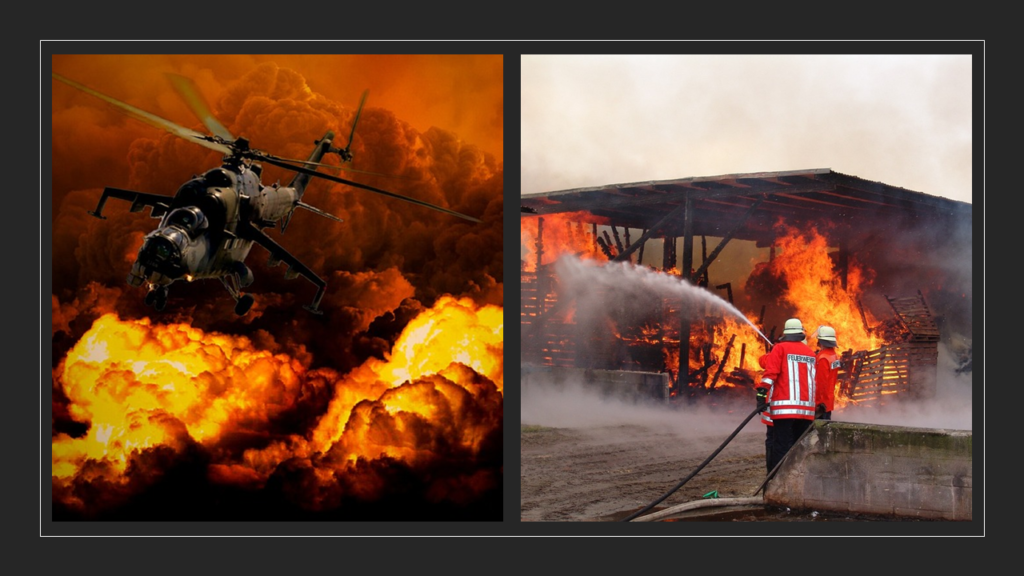
Both systems are essential for our survival and well-being. We are always in some state of war. There is always some virus or bacteria out there is always trying to attack us. There is always some “bad cell” or a “waste debris” that needs to be destroyed before it can become a challenge. Depending on how “dangerous” the threat is, the level of sympathetic activation varies.
At this point, it is important to remember that sympathetic activation is not required only to eliminate threats.
Some level of sympathetic activation is always required, because this system is the driver of almost all activities in our body. If sympathetic system goes completely inactive, heart will simply stop functioning. No energy can be generated without sympathetic system. Sympathetic system is like the gas that is required to keep the fire of life alive. But, pump it too much and it can lead to explosion. Even at “normal” levels, sympathetic system will always cause “wear and tear” that needs to be repaired continuously. And this is where parasympathetic system comes to complete the equation. Parasympathetic system helps repair any damage that is caused by the fire of sympathetic system.
So long as damage is fully repaired, body remains young and healthy. Once the repair systems are overwhelmed, some residual damage keeps remaining unrepaired, and this leads to diseases. I have written a lot on this aspect in several of my previous blogs.
As you can see, the sympathetic and parasympathetic nervous systems are important for our survival and happiness. They are the yin and yang of our nervous system, balancing each other out. They are the poets of our physiology, creating a beautiful and dynamic music that guides our life. The sympathetic nervous system is useful in short bursts, but harmful if activated for too long. It can cause anxiety, inflammation, and chronic diseases. Therefore, it is important to balance the two systems, to find a harmony between calmness and alertness, between peace and passion.
But if we have to choose one over the other, the parasympathetic nervous system is more important for longer survival. It is the system that sustains and nourishes us, that gives us the quality of life that makes survival worthwhile.
Vagus Nerve: The Gateway To Parasympathetic System
For thousands of years, cultures around the world focused on activating parasympathetic nervous system to promote health and longevity. One of the channels to exert control over parasympathetic system is the vagus nerve. Modern science shows that vagus nerve is the master of the parasympathetic nervous system in our body. Vagus nerve is instrumental in controlling the rest and digestive functions of our body that keep us calm and healthy.
The vagus nerve is the longest and most complex of the cranial nerves, branching out from the brainstem to innervate various organs and tissues throughout the head, neck, chest and abdomen.
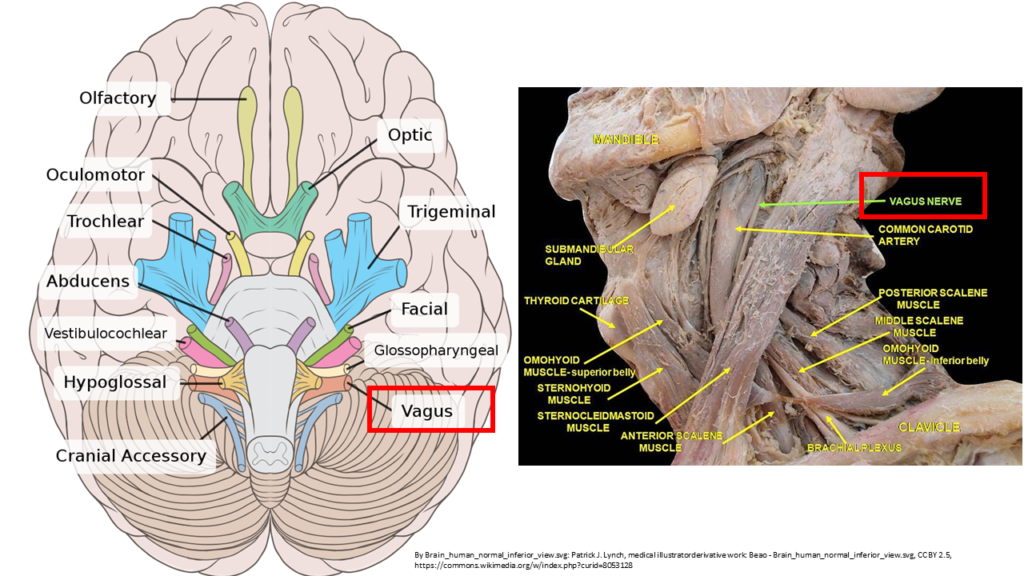
The vagus nerve orchestrates harmonious functioning of many vital systems. It exerts parasympathetic effects and controls our heart rate, blood pressure, breathing, digestion, immunity and mood. It connects us to our emotions, our intuition and our social interactions. It helps us cope with stress, trauma and pain. It is the nerve of compassion, empathy and love.
The vagus nerve is like a poet, weaving words of wisdom and beauty into our inner and outer worlds. It stimulates the production of neurotransmitters such as acetylcholine, serotonin and oxytocin, which enhance our cognitive abilities, creativity and happiness. It activates the regions of the brain involved in language, memory and imagination. It enables us to express ourselves, to communicate with others and to appreciate the wonders of life.
It is the nerve that makes us human.
Revolutionizing Wellness: Everyday Techniques for Vagus Nerve Activation
For centuries, mystics have known the secrets of the vagus nerve. They have practiced various techniques to activate it and enhance its functions. Using these techniques they have experienced profound states of bliss, peace, compassion, and connection with the divine.
But, we are no yogis or mystics. We are simple normal people. So, is it possible for us to also try and activate our vagus nerve? Answer is a resounding yes. As I already mentioned- most cultures already knew the benefits of activating vagus nerve. Through various festivals and rituals, these cultures used religion to propagate practices that can significantly activate vagus nerve. Chanting of mantras and hymns, the reverberating sound of prayers inside temple/church/mosque, the application of tilak or bindi, meditation, fasting- all these religious rituals have tremendous effect towards activating our vagus nerve.
As we discussed earlier, vagus is the longest nerve in our body. Throughout its journey in body, there are several points where it can be physically activated. This system of activating a nerve is based on the Chinese practice of acupressure and acupuncture. As per this system, there are 4 places where vagus nerve can be activated:
1. The third eye point: This point is located between the eyebrows, where the bridge of the nose meets the forehead. It is associated with intuition, insight, and spiritual awareness. Pressing on this point stimulates vagus. This point can calm the mind, relieve stress, and improve mental clarity. It can also stimulate the pineal gland, which produces melatonin, a hormone that regulates sleep cycles and mood.
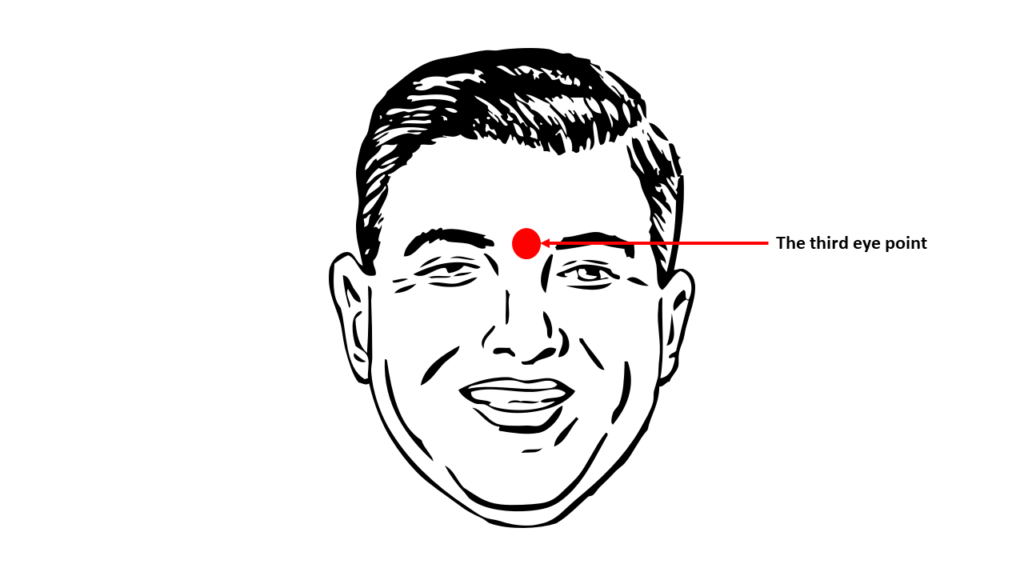
2. The ear points: There are several points on the ear that can activate the vagus nerve. One of them is called Shen Men or Heavenly Gate, which is located at the upper part of the ear, where it curves into a triangular shape. Another one is called Daith or Heart’s Ear Gate, which is located at the innermost part of the ear cartilage, where it forms a small fold. Pressing on these points can reduce anxiety, depression, pain, and inflammation. They can also lower blood pressure and heart rate and improve digestion and immunity.
In lot of cultures, ear piercing with ornamental rings is promoted. Most of these piercings are through these points, so that they get automatically stimulated as one wears and removes these ornaments- isn’t that amazing!
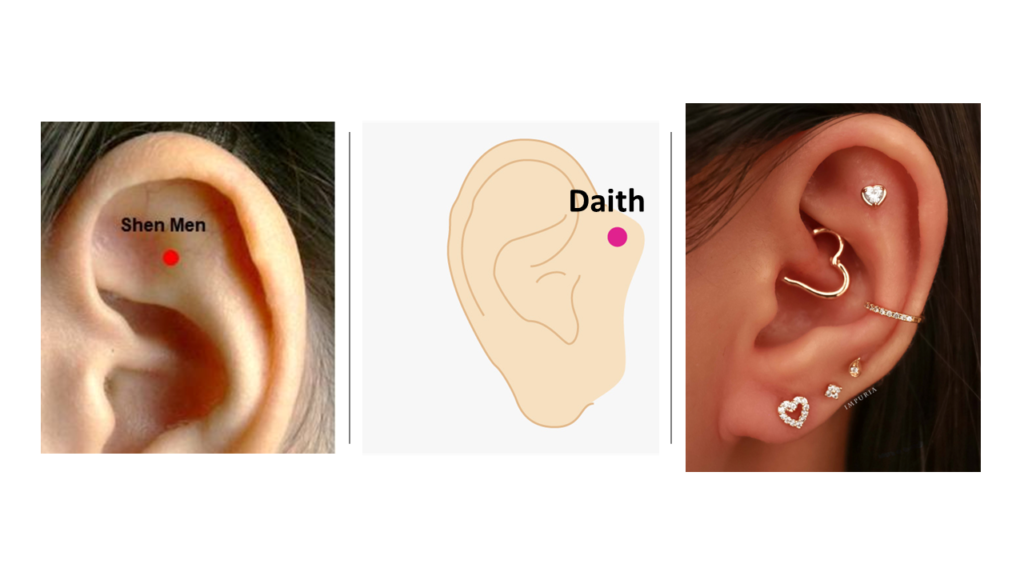
3. The neck points: There are two points on the neck that can activate the vagus nerve. One of them is called Heavenly Pillar or Heavenly Window, which is located at the base of the skull, on either side of the spine. Another one is called Heavenly Rushing or Celestial Well, which is located on either side of the neck, below the earlobe. Pressing on these points can relax the muscles and nerves in the neck and head. They can also ease headaches, insomnia, dizziness, and tinnitus.
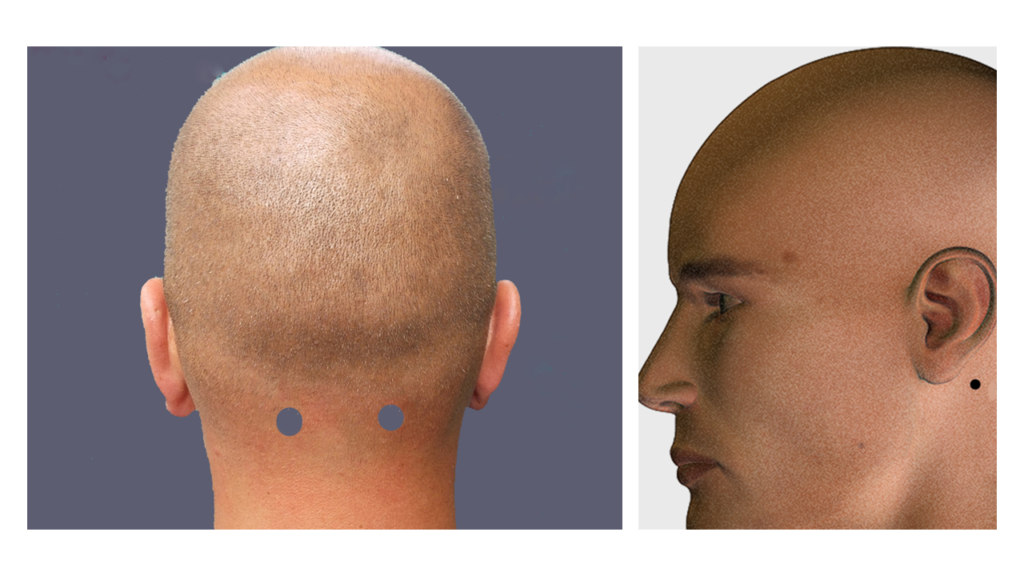
4. The chest point: Located in the center of the chest, four finger widths up from the base of the breastbone is the point called Sea of Tranquility or Conception Vessel 17 (CV 17). Pressing on this point can open up the chest and lungs and improve breathing. They can also regulate emotions, especially anger and frustration.
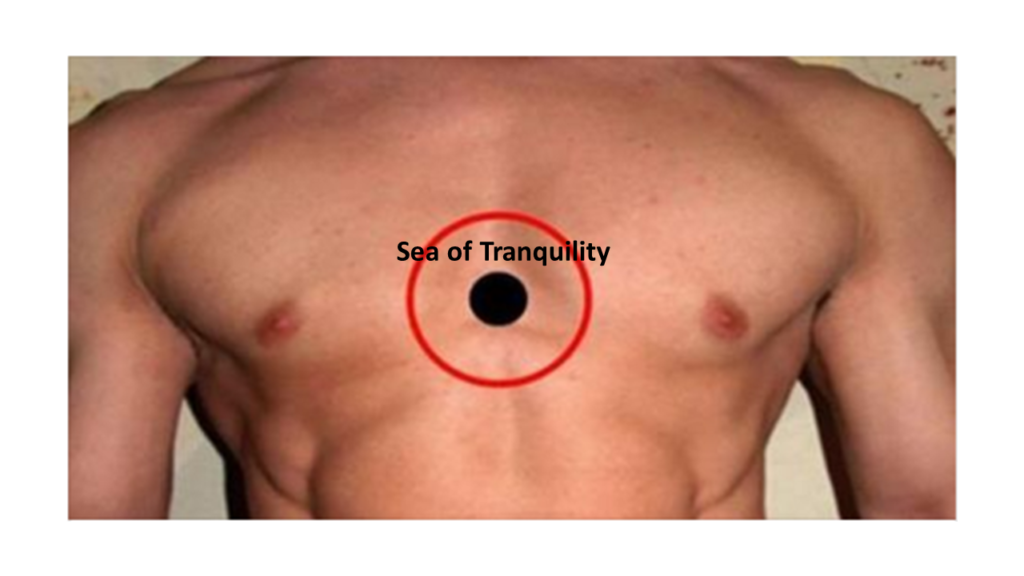
5. The foot point: Located on the top of the foot, between the big toe and the second toe is another point called Great Rushing or Liver 3 (LV 3). Pressing on this point has similar effect as pressing on the chest point.

Apart from the above acupressure techniques, there are 7 other simple ways using which any normal person can activate vagus nerve and parasympathetic system:
1. Chanting/singing: Chanting is a powerful technique to stimulate the vagus nerve. By producing sounds with our voice, we can vibrate our vocal cords and send signals to our vagus nerve. These sounds will also activate the vagal nerve endings in the ear. These signals can activate the areas of the brain that are involved in emotion regulation, social bonding, and self-awareness. Chanting can also create a resonance between our heart and brain, creating a sense of coherence and unity. Chanting can also induce a state of flow, where we lose ourselves in the moment and feel connected to something greater than ourselves. So, don’t ignore chanting of hymns or mantras- they activate your vagus!
A similar effect is also seen via simply singing or humming. So, just sing a song and enjoy, as the tunes activate your vagus!
2. Breathing practices: Breathwork is one of the simplest and most effective ways to activate the vagus nerve. By breathing deeply and slowly, we can lower our heart rate and blood pressure, calm our nervous system, and reduce stress. We can also modulate our breathing patterns to create different effects. For example, by exhaling longer than inhaling, we can increase our vagal tone and enhance our relaxation response. This is the essence of Indian breathing system called pranayama. By breathing in a rhythmic way, we can synchronize our brain waves and enter a state of coherence and harmony.
3. Fasting: Fasting is a one great ritual that simply activates body’s repair system in a profound way. Vagus nerve, being the master of parasympathetic system, gets readily activated with fasting to join the repair work. When food intake is restricted, cells don’t have much to burn. Body itself slows down the metabolism drastically. Such slow and calm state is an ideal playground for vagus. “Slow” and “calm” are key words though. In many people, hunger leads to anger. Anger is an enemy of vagus. If you get agitated with fasting, vagus cannot be activated. You need to be in a state of calm and peace when you are fasting. Combine meditation with fasting and you will get the maximum effect.
4. Laughing: The simple act of laughing will activate vagus. Laughing give sensorial signal to brain that there is no danger around at all. Such signal depresses sympathetic system and activates vagus. But, your laugh has to be genuine. You cannot be stressed inside your head and laughing artificially.
5. Meditation: Meditation strongly activates the vagus nerve. Thoughts are root causes of anxiety/anger. Meditation calms down our mind. Calmness is a friend of vagus. Add chanting to meditation for best results. Lot of yogic meditation involves chanting of “aum” with meditation and is a powerful way of activating vagus.
6. Yoga: Yoga is a holistic practice that combines physical postures, breathing exercises, and meditation. It thus stimulates the vagus nerve in multiple ways.
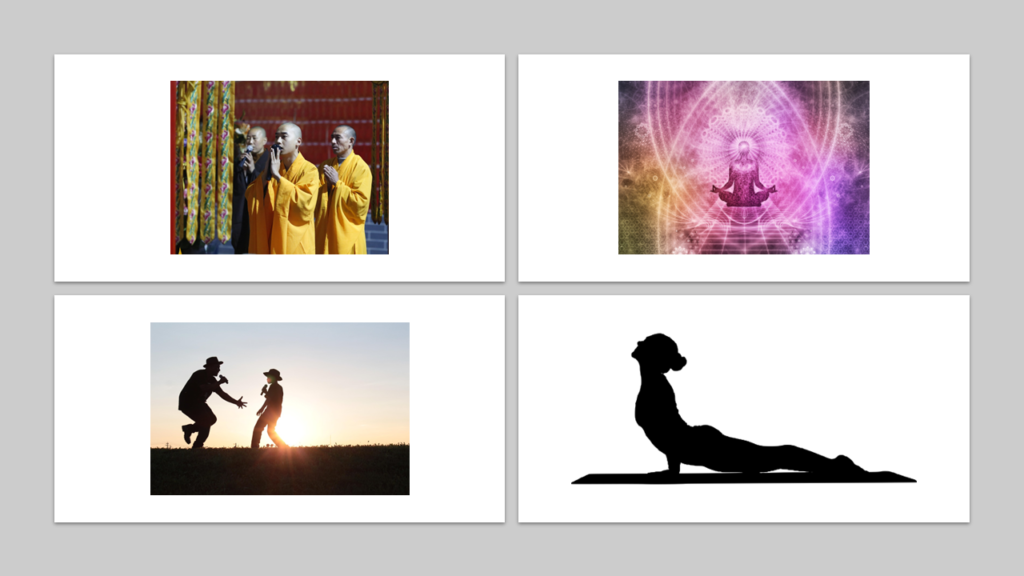
7. Cold exposure: Exposing yourself to cold temperatures can trigger the vagus nerve. This technique usually works by activating the dive reflex. Dive reflex is a physiological response that helps us survive underwater. When we encounter cold water or air, our body conserves oxygen and energy by slowing down the heart rate and blood flow. This happens via stimulation of vagus nerve. You can try taking a cold shower, splashing cold water on your face, or drinking ice water. I am personally not a great fan of this technique- it is too artificial.
These are just some of the ways to activate the vagus nerve and enjoy its benefits. By doing so, we can improve our physical and mental health, as well as our quality of life. The vagus nerve is truly a gift from nature. It is human biology’s poetic expression connecting our inner harmony and outer environment. I hope this blog will help you cherish this gift within you and nurture it with love and gratitude.
I would like to thank Dr Mayur Vadhel for inspiring me to write this article. Mayur is an accomplished orthopedician from Navi Mumbai and a very dear friend!




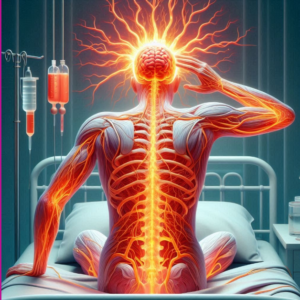

As usual very informative
Thank You Rajesh!
I just like the helpful information you provide to your articles. I will bookmark your weblog and take a look at once more right here regularly. I’m quite certain I’ll learn many new stuff right right here! Best of luck for the next!
Thank you I have just been searching for information approximately this topic for a while and yours is the best I have found out so far However what in regards to the bottom line Are you certain concerning the supply